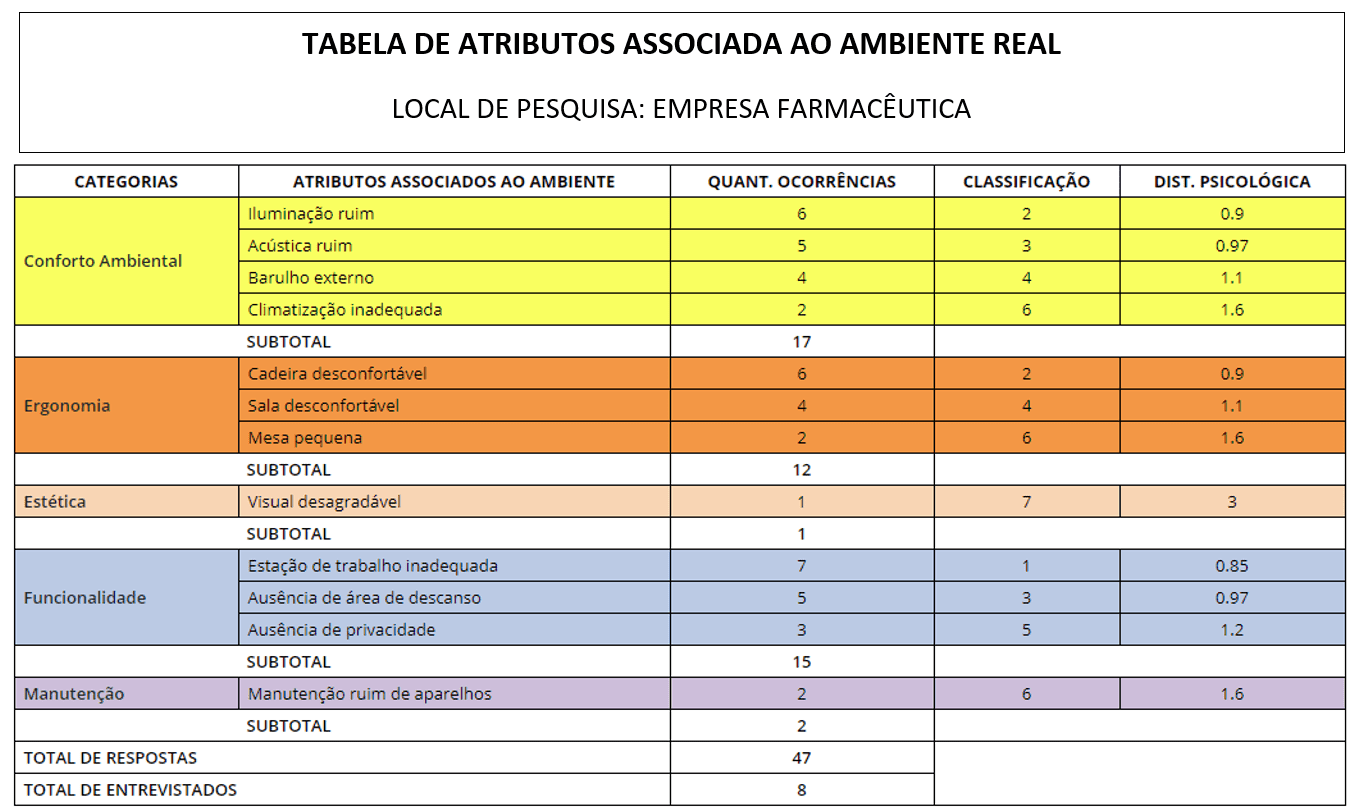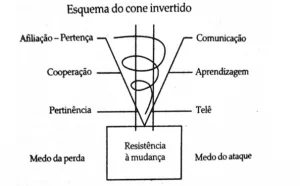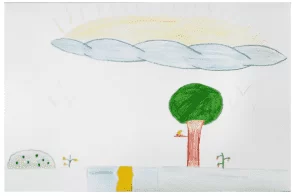ORIGINAL ARTICLE
NIEMEYER, Michelle Caroline [1], NIEMEYER, Carlos Augusto da Costa [2]
NIEMEYER, Michelle Caroline. NIEMEYER, Carlos Augusto da Costa. Environmental perception as a strategy for investigating the built environment: Case study in work environment. Revista Científica Multidisciplinar Núcleo do Conhecimento. Year 05, Ed. 03, Vol. 03, pp. 69-80. March 2020. ISSN: 2448-0959, Access link in: https://www.nucleodoconhecimento.com.br/psychology/investigative-strategy
SUMMARY
The process of planning the built environment requires a series of investigative procedures, among them knowing the environmental perception of its users. The article presents a case study aimed at evaluating the suitability of a work environment adopting the methodology called “induced attributes” also known as the tool “constellation of attributes”, derived from studies of environmental psychology. The article works on behavioral issues generated from physical and sensory aspects stimulated by the organization of the environment constructed and raised by the investigative tool. This study, conducted in the administrative sector of a pharmaceutical company, located in the region of Campinas-SP, conducted interviews with employees in order to stimulate their cognitive perception based on key questions addressed by the researchers, thus generating data that feed the computational program that will identify and qualify environmental attributes involved in the perception. The results obtained reveal the level of psychological adjustment person-environment, allowing to weave valuable information to researchers to adjust the environment to the needs of its users and, consequently, to provide well-being and increase productivity.
Keywords: Environmental perception, constellation of attributes, environmental psychology.
1. INTRODUCTION
Architecture is considered a functional art when establishing a physical structure that, when well resolved, reveals all its essence transmitting comfort and well-being to users. Pragmatically, the architecture must effectively meet the intended uses or function, creating environments that provide convenience for the fulfillment of specific activities under penalty of not being considered an architecture. In this regard, Zevi (1977) illuminates the classical foundation of good architecture and its protagonism in the creation of interior spaces “full of intentions”, and thus does not allow to apprehend it without engaging in an intense experience of perception and appropriation, since it seduces our senses and “elevates us spiritually”. The spatiality of the architectural body can only be apprehended by the unfolding of the experience of spatial use and involvement, at which time we take “possession” of the place, realizing in all its fullness the experience of the perception that the environment offers to our senses.
Tuan (1980), when studying the relationship between people and places, through spatial perception and representation, describes and names this perceptual experience as a “feeling of topophilia” based on elements that awaken cognitive perceptions, whether negative or positive in relation to the place. This study contributed to the understanding that we have today of the dichotomy between “place”, understood as an enclosure loaded with affection and “space”, an undifferentiated and vague enclosure, generating opposite distinctions for the ability to provide distinct sensory experiences personified in senses of belonging, attractiveness, protection, security, privacy, preservation and others. Ettinger (1964) worked this line of reasoning in work environments by observing that it is possible to improve productivity by adding environmental improvements by improving the interaction of the person with their workstation promoting pleasant sensations with the place.
Thus, the so-called “pleasantness” of the place, although perceived unconsciously, explains, for example, why we like one place more than another, encouraging ourselves to judge how we perceive and idealize the world we inhabit and, so to speak, determining our environmental values. In the work context, good architecture is important due to the possibility of providing environmental improvements and building empathy with the workstation generating well-being. The feeling of pleasantness does not solve functional problems by itself, but makes the person more comfortable, establishing an affective link by optimizing cognitive aspects, which generates positive impacts on the productivity of the work system. Since the industrial revolution, quality in work environments has been an important demand, whether physical, psychological or environmental, directly or indirectly influencing productivity and occupational health.
In this sense, the concern with labor productivity began with Taylor at the beginning of the 20th century and his “Scientific Administration” in order to ensure the best cost/benefit to production systems. The author observed that efficiency depends not only on incentives and methods, but also on a set of favorable conditions, including the improvement of the physical environment. (CHIAVENATO, 2004). Today, the science of work has no doubt that quality in the work environment is a direct reflection of environmental conditions that are impacted by a multiplicity of active factors such as perception of work safety, adequacy of workload, relationship with colleagues, and, finally, physical conditions such as environmental adjustments – acoustic, luminic, thermal – among others. (SOUZA; LOURES; MARTINS, 2012).
For Madalozzo (2016), although there have been substantial improvements in the quality of life of workers such as organizational and legal achievements – unions, labor laws, social benefits and improvements in work organization – there is still, in the employer’ s environment, a certain underestimation of the emotional aspect of employees, such as the damage caused by stress in the work environment and relevant cognitive symptoms, which may cause demotivation and , as a result, loss of productivity. So that, from a systemic perspective, person and environment are not approached separately and physical and psychological components are moved by “environmental” and “cultural” contexts, especially by the action of the user’s “memory”, thus evoking meanings that translate into anxieties, expectations, judgments, conducts and other cognitive mechanisms operated as a sensory response of the occupants to the place they inhabit. (MACIEL; CAVALCANTE, 2008; DEL RIO, 1996).
Each individual responds in a particular way to this relationship, resulting in cognitive actions that make him have more or less empathy with the environment, impressions that result in what we call “environmental perception”. Thus, human behavior results from this perceptual process, that is, from this person-environment coexistence modulated by previous particular and cultural experiences that act sensitively in our way of seeing, feeling and judging the environments. In this study, we intend to report a case study focused on the environmental perception of a corporate space, seeking to reflect on the adequacy and quality of places (or absence of these) from the perspective of their occupants adopting the methodology of “induced attributes” also known for its graphic form called “constellation of attributes”, derived from studies of environmental psychology. We understand that environmental quality is related to the condition of this perception and that it is a perceptive condition that is the protagonist of the level of adjustment of the place to the desires and needs of its users.
2. ENVIRONMENTAL PERCEPTION AS A STRATEGY FOR UNDERSTANDING THE ENVIRONMENT
Gurgel (2013) rescues the importance of a good interior design project as a “motivating element of emotions in human relations”, and, for this, highlights the previous existence of a well-prepared briefing from a careful investigation of the user’s profile, occupants, their seizures and intentions of use, which will determine valuable instructions to the designer that will facilitate the final configuration of the environments , equipment, furniture, dimensions, visual stimuli, environmental comfort and other elements of qualification of the place to fulfill the established functions. Several concepts emerge in this sense. Bernardi et al (2011) stresses that the concept of architectural “accessibility” should be contemplated in the spatial perception of the individual, and thus sensory experiences are considered essential to organize places and to obtain better functional and cognitive performance.
In the so-called “proximity environments”, such as workplaces and others, a projective approach called “social design” was consolidated that works the concept of “cooperation architecture” with participatory bias planning models whose designer assumes a “behavioral consultant” stance committed more to the design process than to the final product (SOMMER , 1983). Participating means taking part in the design process, accompanying, in a qualified way, the construction of the needs program and the definition of the aesthetic-functional of the places. Different investigative tools for the analysis of environmental perception emerged from this purpose, in order to broaden the relational understanding of the person-environment, its desires and cognitive demands for the construction of places that provide comfort and well-being to its occupants. (SOMMER, 1973; 2002).
Thus, an interdisciplinarity and a new field of study were constructed between architecture and environmental psychology in order to conceive harmonic environments based on the understanding of relational interaction issues involving a collective of users and the role of the physical-cognitive elements working there such as furniture, accessibility, dimensional space, proximity, environmental comfort, etc. that are captured through interviews and evaluation models , seizing the desired configuration to the environment. Today, we know that positive environmental stimuli help build strong bonds of attractiveness and belonging to the place. In work environments, this notion is identified with a harmonious and comfortable environment, generating well-being and conducive to productivity since operaism is favored by the existence of pleasant workstations, causing multiple benefits to both the worker and the company, issues analyzed by environmental psychology.
In this context, considering these objectives, environmental psychology should be understood as an area of study that directly affects and acts under psychological science and was also appropriated by architecture. Due to these approaches, the main scope is to study, and also to reflect on the relationships that occur between environmental and behavioral factors and how this can impact on our daily behavior in a given context (CORRAL-VERDUGO, 2005; RIVLIN, 2003). It was born and prospered from barker’s so-called “ecological experiment” (1968) which studied the environmental effects on human behavior called “environment-behavior”, or in its reverse form, called “environmental behavior”, this when the environment is slowly affected by our behavior.
Therefore, it is necessary to understand that human behavior can influence or also be influenced by the environment, thus covering several scales of approach such as the “microenvironment” (domestic spaces), “proximity environments” (workplaces and congeners), “public collective environments” and even in the macro scale, large open or natural spaces (CAMPOS-DE-CARVALHO; CAVALCANTE; NÓBREGA, 2017). In the wake of this knowledge, an additional field of study was generated called “ergonomics”, fundamental for the construction of healthy environments, and, thus, seeks to promote adaptations in the work environment to provide the performance of tasks with better performance, satisfaction and safety, preserving, in this process, occupational health and productivity at work. (VILAROUCO; ANDRETO, 2008).
In the investigative process in architecture and design, technical evaluations and behavioral evaluations together make up an efficient methodological procedure for quality control of the built environment also called “Post-Occupation Assessment” (APO), with wide use in several approach scales (ORNSTEIN, 1992). Environmental psychology appears in the understanding of psychological aspects from the users’ point of view, anchored in ergonomic analyses of the constructed environment. Considering the provisions, the on-screen study focuses on understanding the psychological factors involved in a real environment, the central office of a company, seen here as a case study, seeking to capture expectations, desires and needs of users. Reading and measuring the demands related to the field of cognition become difficult to measure without using appropriate methods as we will see.
3. THE METHOD AND ITS APPLICATION
Diagrams are considered important project management tools because they allow “to organize information and ideas for the presentation of quantitative and qualitative data in a fast and accessible way” allowing clear visualization of results no matter how complex the evaluated phenomenon (AMBROSE; HARRIS, 2011 apud PISSETTI; VIEIRA, 2013, p. 2). It is considered, in this respect, as an important tool for managing and planning the design because it allows understanding of the customer’s needs, whatever the information to be generated. The assimilation of an occurrence is more easily apprehended from diagrams because it presents, geometrically, difficult realities to measure, such as the imaginability of a place.
For this aspect and as a starting point for analysis and understanding of the psychological factors involved in this perception analysis, the method of “induced attributes” or “Constellation of Attributes” was applied widely used in research of ergonomic analysis of the Constructed Environment and known for its graphical approach in the form of a constellation. This technique was pioneered by Moles (1968) and later perfected by Ekambi-Schmidt (1974) and stands out for allowing to materialize graphically the psychological awareness of users in relation to the built space, also allowing to raise the level of adjustment of the environment in relation to its users.
Ekambi-Schmidt (op. cit.), states that the method seeks to separate the stereotyped image from the subjective image, seeking to isolate and analyze psychological variables (attributes) based on two distinct realities: the tangible – real – object and the imaginary perception generated by the sociocultural affinities and conditionings of individuals about a given space. The clash between the two conceptions brings out a series of listed attributes that will serve to qualify the perception of the space lived in the point of view if its users. Two key questions of investigative character are addressed to the respondents, in this case, a central office of a pharmaceutical company, located in the region and Campinas-SP. There were 08 (eight) resident employees who work in the same and large room.
The first question always addressed individually aimed to capture desires and longings about a hypothetical work environment that, in your view, caused deep pleasantness: what images or ideas come to mind when you think of a work office? The objective was to trigger cultural and memory mechanisms, although conditioned by preconceived stereotypes, which requires a filtering done in the next stage, resulting in a list of admirable attributes to a hypothetical space. The second question asked in the sequence refers to the impression of the environment in use: what images or ideas come to mind when you think about this work environment? The answer aims to capture a concrete and real opinion of environmental perception in that place.
The answers are open and contemplated all the answers informed, always noted by the researcher in individual forms, but it was not necessary to nominally identify the person, which avoids fears and embarrassments. The objective of these is to feed the program that will generate the map of environmental perception, identifying and quantifying attributes linked to the perception of the environment raised in the two stages of the in situ interview. Finally, it resulted in the design of graphic models for each declared situation. The tool allows to generate, thus, a chain of attributes that allows to demonstrate which are the most relevant obtained in the interviews and classified according to the frequency of appearance in the answers.
Therefore, it is necessary to highlight that the diagram was responsible for generating “psychological distances” (the bars) whose size is calculated by the mathematical model (equations 1 and 2) from the frequency in which they are cited, thus allowing a geometric view in relation to a given phenomenon of cognitive character. In this perspective, the diagram was generated and plotted and, for this purpose, was based on the definition of the probability (Pi) of attribute association (i), which eventually generated the “psychological distance” (D) in “cm” that represents the connections of each attribute to the object, described respectively below:
Where:
Pi = probability of association of attribute i
D = psychological distance from attribute (cm)
ni = number of appearances of attribute i
N = total responses
The tool is computerized and available on the public access portal (via Google Chrome)[3]. Two “constellations” (real and imaginary) were generated and are the center of the object of study (the office). Its attributes were connected by means of straight lines, connected to the answers raised in the interviews (see tables). The closer the connections (in cm), the greater the affinity of this attribute with the object, and, on the other hand, the farther the connections (the greater lines), the lower the relationship of the attribute in the perception of the reported object. When correlated, the diagrams allow mapping the cognitive phenomenon of a collective in the face of demands for environmental adequacy to the uses and expectations of pleasantness. Each response group receives a chromatic code associated with its category and are colors that repeat in the graphics.
4. RESULTS AND DISCUSSIONS
The diagrams generated allow the visualization of the level of adjustment of the environment to the needs of users whose psychological distances (here observed by the length of the bars in cm) reflect the sensory demands raised. Next, we present the statement tables, starting with the attribute tables of the imaginary environment and, in the sequence, of the real environment. Finally, the two corresponding constellation diagrams are presented and that characterize the innovation of this graphic method to understand the sensory and emotional responses of users in relation to their workplace. The following are the maps with the appropriate observations and relevant analyses:
Table 1: Attribute Constellation Diagram ref. Real Environment

Source: Prepared by the authors (2020)
Table 2: Attribute Constellation Diagram ref. Imaginary Environment
Source: Prepared by the authors (2020)
Source: Prepared by the authors (2020)
The results generated showed that the perception of the real environment is deeply impacted by demands related to “environmental comfort” in the workplace. The attributes most raised by the employees were pertinent to the luminic, thermal and acoustic performance, which corresponds to the expectations and longings in the imaginary environment where it proved to be massive indication for environments with better performance and pleasantness in these questions. We know that environmental discomfort influences the levels of care, affecting productivity and is also responsible for poor performance in intellectual activities. The second most demanded category was pertinent to “ergonomics”, with strong criticism of the lack of suitability of functional furniture, especially chairs and tables, with dimensions not adjusted to the needs of the activity developed there.
This demand was responsible for the strong observation of the employees regarding the need for a more adjusted and ergonomic furniture. Individually, issues related to “functionality” have garnered strong demand in the real environment, especially regarding the inadequacy of the workstation considered “tight”, “uncomfortable” or “without privacy”. In the imaginary environment, this demand will have its correspondence in the perception of greater importance to the issues of qualification of the environment, here seen as more privacy to the workstations and the importance of a “rest room”, referring to a living environment with pantry and toilet for the necessary breaks in the journey after lunch or coffee in the afternoon. Other demands raised by the researchers refer to the aesthetics, maintenance and safety mentioned and that can be translated by lack of pleasantness of the environments, which, if not considered, can cause detachment, mental fatigue and discouragement to employees.
FINAL CONSIDERATIONS
A careful look shows evidence of physical and cognitive inadequacy in the work room, as shown in the diagrams developed, explaining that there is a certain level of misadjustment in the person-environment relationship, which explains the little empathy with the workstations, here understood as ergonomic and functional inadequacies. The functional and relational dimension, when well adjusted, is fundamental to establish a climate of attractiveness with the place, since the space is closely related to our senses, providing well-being and, consequently, reinforcing the feeling of belonging and empathy with the company. Feelings of strong psychological significance such as empathy, security and belonging, when not properly contemplated, can generate malaise and negative impacts on employee productivity.
The case study on screen brought out the importance of what good architecture calls “restorative environments” (GRESSLER, 2014; ALVES, 2011), that is, “escape” environments that contribute to renew energies and reduce mental fatigue. Defendant in the diagrams, according to the reports of the employees themselves who called by the suggestive name of “rest room with pantry”, these restorative environments bring important physical, mental and social benefits for reducing stress and antisocial behaviors, and can be conceived at different scales of approach: in the work environment or in the scale of the building, making up the spaces of coexistence (being better those who have gardens). On the scale of the neighborhood or city we have the public gardens and the neighborhood squares and on the scale of the city we have the parks and urban forests with the same purposes on a macro scale.
In all scales mentioned the function is the same: to restore social tensions and relieve cognitive pressures. In the work environment, the reason for this study, these environments allow a restorative energy pause, renew attention and, consequently, contribute effectively to the reduction of mental fatigue and stress. Currently, new spatial solutions have been developed in work environments that prioritize programmatic conceptions for specific environments near workstations aimed at “cognitive escape”, without deserving other aspects no less important related properly to workstations such as ergonomic and visual adaptations, which undoubtedly contributes to the restoration of environmental quality and attachment to the place. The methodology based on interviews and assembly of diagrams demonstrated its effectiveness by proposing a graphic survey on the phenomenon of perception and psychological adaptation to the place, demonstrating to be an essential and additional tool to investigate the built environment.
REFERENCES
ALVES, S. Ambientes Restauradores. In: CAVALCANTE, S; ELALI, G. Temas Básicos em Psicologia Ambiental. 1ª ed. Petrópolis: Vozes, 2011.
BARKER, R. G. Ecological Psychology. Stanford: University Press, 1968.
BERNARDI, N. et al. O desenho universal no processo de projeto. In: KOWALTOWSKI, D. et al. O processo de projeto em arquitetura: da teoria à tecnologia. São Paulo: Oficina de Textos, 2011.
CAMPOS-DE-CARVALHO, M. L; CAVALCANTE, S; NÓBREGA, L. M. A, Ambiente. In: CAVALCANTE, S; ELALI, G. Temas básicos em Psicologia Ambiental. Petrópolis: Vozes, 2017.
CHIAVENATO, I. Introdução a Teoria Geral da Administração. Rio de Janeiro: Elsevier, 2004.
CORRAL-VERDUGO, V. Psicologia Ambiental: objeto, realidades sócio físicas e visões culturais de interações ambiente-comportamento. Psicologia USP, v. 16, n. 1-2, p. 71-87, 2005.
ETTINGER, K. Direção e Produtividade. Direção, Organização e Administração de Empresas. Manual de Ensino 1. 1ª. ed. São Paulo: IBRASA, 1964.
EKAMBI-SCHIMIDT, J. La percepción del habitat. Barcelona: Gili, 1974.
GRESSLER, S. C. O descanso e a teoria dos ambientes restauradores. 2014. 277f. Tese (Doutorado em Psicologia Social) – Universidade de Brasília, Brasília, 2014.
GURGEL, M. Projetando espaços. 5ª ed. São Paulo: Ed. Senac, 2013.
MACIEL, R. H; CAVALCANTE, S. Métodos de avaliação da percepção ambiental. In: GUNTHER, H; PINHEIRO, J. Q. Métodos de pesquisa nos estudos pessoa-ambiente. São Paulo: Casa do Psicólogo, 2008.
MADALOZZO, M. M. Preservação da Saúde e Prevenção de Acidentes de Trabalho: A Urgência da Psicologia Nesse Contexto. Estud. psicol., v. 11, n. 3, set./dez. 2016.
MOLES, A. Sociodinâmica de la Cultura. BARCELONA: Gili, 1968.
PISSETTI, R. F; VIEIRA, G. B. Processo de Design: técnicas de visualização, análise e síntese de dados. In: I Congresso de Pesquisa e Extensão da FSG, 2013.
RIVLIN, L, Olhando o passado e o futuro: revelando pressupostos sobre as interrelações pessoa-ambiente. Estudos de Psicologia, v. 8, n. 2, p. 215-220, 2003.
SOMMER, R. Social Design: Creating building with people in mind. Englewood Cliffs, NJ: Prentice-Hall, Inc, 1983.
SOMMER, R. Espaço Pessoal. São Paulo: Ed. Pedagógica e Universitária, 1973.
SOMMER, R. O desenvolvimento e a aplicação dos conceitos de espaço pessoal. Projeto do Lugar: colaboração entre psicologia, arquitetura e urbanismo. Rio de Janeiro: Contra Capa/PROARQ, 2002.
SOUZA, A. C., LOURES, S. L. C.; MARTINS, M. F. A Qualidade de Vida no Ambiente de Trabalho Sob a Ótica dos Professores da Rede Pública. Revista Científica da FAMINAS, v.7, n. 3, p. 141-148, 2012.
TUAN, Y. F. Topofilia: um estudo da percepção, atitudes e valores do meio ambiente. São Paulo: DIFEL, 1980.
VILAROUCO, V; ANDRETO, L. Avaliando Desempenho de espaços de trabalho sob o enfoque da ergonomia do ambiente construído. Produção, v.18, n. 3, p. 523-539, set/dez. 2008.
VERGARA, S. C. Gestão de Pessoas. 16ª. ed. São Paulo. Editora Atlas, 2016.
ZEVI, B. Saber Ver a Arquitectura. 2ª. ed. Lisboa: Arcádia, 1977, 220p.
3. http://constelacao.fec.unicamp.br
[1] Psychologist and Psychology Specialist.
[2] Architect and PhD in Architecture and City from FAU-Unicamp.
Sent: February, 2020.
Approved: March, 2020.





